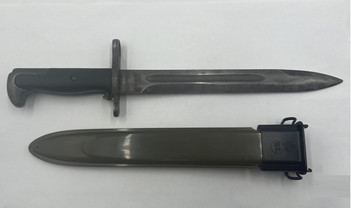M1 Bayonet Care/Restoration: A Short Guide
Aug 24th 2024
So you’re the proud new owner of an M1 bayonet, a model the historical value of which is nigh immeasurable.
These were the shorter bayonets that were issued starting in 1943 to soldiers that may have previously been equipped with the larger, longer, sword-style M1905 bayonets.
The M1 is commonly associated with the Garand, as they were often used in concert.
Nonetheless, suppose you’ve just gotten one that’s a bit worse for wear and you’re looking into ways to bring it back to snuff and make it look better before storage or display.
Here’s what to know.
On Light Restoration
First off, the natural patina of your M1 bayonet is an endearment, not a detractor. If it’s all dark oxide, maybe you should just leave that be. These things don’t look quite right when they’re all shiny to begin with.
But, if your M1 bayonet is covered in light rust, say, on the blade, there are some things you can do about that.
If there’s a little bit of rust on the blade (see: a little bit!) you might be able to restore the blade with some extra fine steel wool and a bit of vinegar.
Apply some vinegar to the blade and buff off the rust. If there’s a thicker coating of rust you might need to take another avenue. If you need a little more elbow grease than the fine steel wool is providing, consider a brass gun cleaning brush, as this will be powerful enough to remove light rust without scratching the steel underneath.
Also, you don’t want the blade to really shine as they weren’t made with a mirror finish to begin with and too much gleam will actually just look unnatural.
As for the scales, leave them be, too. Some would tell you to take them off so you can clean the tang under them, but we’re not necessarily in that camp.
For one, if they’re black, they’re probably phenolic. That’s a tough, corrosion-impervious synthetic composite that doesn’t need help from you.
Worse yet, if you remove them and try to replace them, they have a propensity to crack. So we say leave them the way they are. You can use a nylon brush to scrub off any grime if you want, though.
If the grips are wood, we still don’t recommend trying to remove and clean them. If they’re looking dark and like they might crack, treat them with a wood conditioning oil, a light application only, to protect them.

On Long-Term Care/Storage
Now suppose you have an M1 bayonet that you either want to display or put away for long-term storage, but you want it to look its best.
The biggest thing you have to be wary of is corrosion, especially if you just bent over backwards to strip the blade of rust.
If you did that, you now need to reseal the blade off against atmospheric moisture so that it won’t rust again.
For that, you’ll want some sort of grease or oil. A good one is Hoppe’s gun grease, which is specifically intended to protect against corrosion in storage.
Apply a light coat to the blade and the crossguard using a rag, then wipe away any excess. You don’t want to leave a lot of grease on there as it will become difficult to remove later. Also, you don’t want to see a layer of grease or oil as that will damage the aesthetics.
Also, if your M1 bayonet came with a scabbard or sheath, if you’re storing it for a longer period of time, store them separately. Storing the bayonet in the scabbard can trap moisture and may result in rust. This is not always the case but it’s also not something you want to find out after the fact.
A Note on Sharpening
If you check out the forums, one of the most common questions is “why is my bayonet dull, should I sharpen it?” which is met with a colorful variety of responses ranging from outright incredulity to offended disbelief.
Here’s the interesting truth. The M1 bayonet was designed as a thrusting weapon, not as a cutting implement. The edges are intentionally dull, only the point should be sharp.
Hence, if you sharpen the edge, you will be harming the collector value. Leave it dull as it is. That’s the way the M1 was intended.
If you have a bayonet that does have a sharpened edge, that was probably put there by someone that carried it as a field modification to make the thing more utilitarian. There’s no need to intentionally re-dull the blade in this scenario, though.
Here for an M1 Bayonet?
Landed here because you’re in the market for an M1 bayonet for your collection? Take a look through our catalog of bayonets for sale via the previous link and see if there’s anything there that catches your eye.
Also, if you’re looking for a specific model or something that’s hard to find and you don’t see it, get in touch with us and we will see if we can find it for you.

